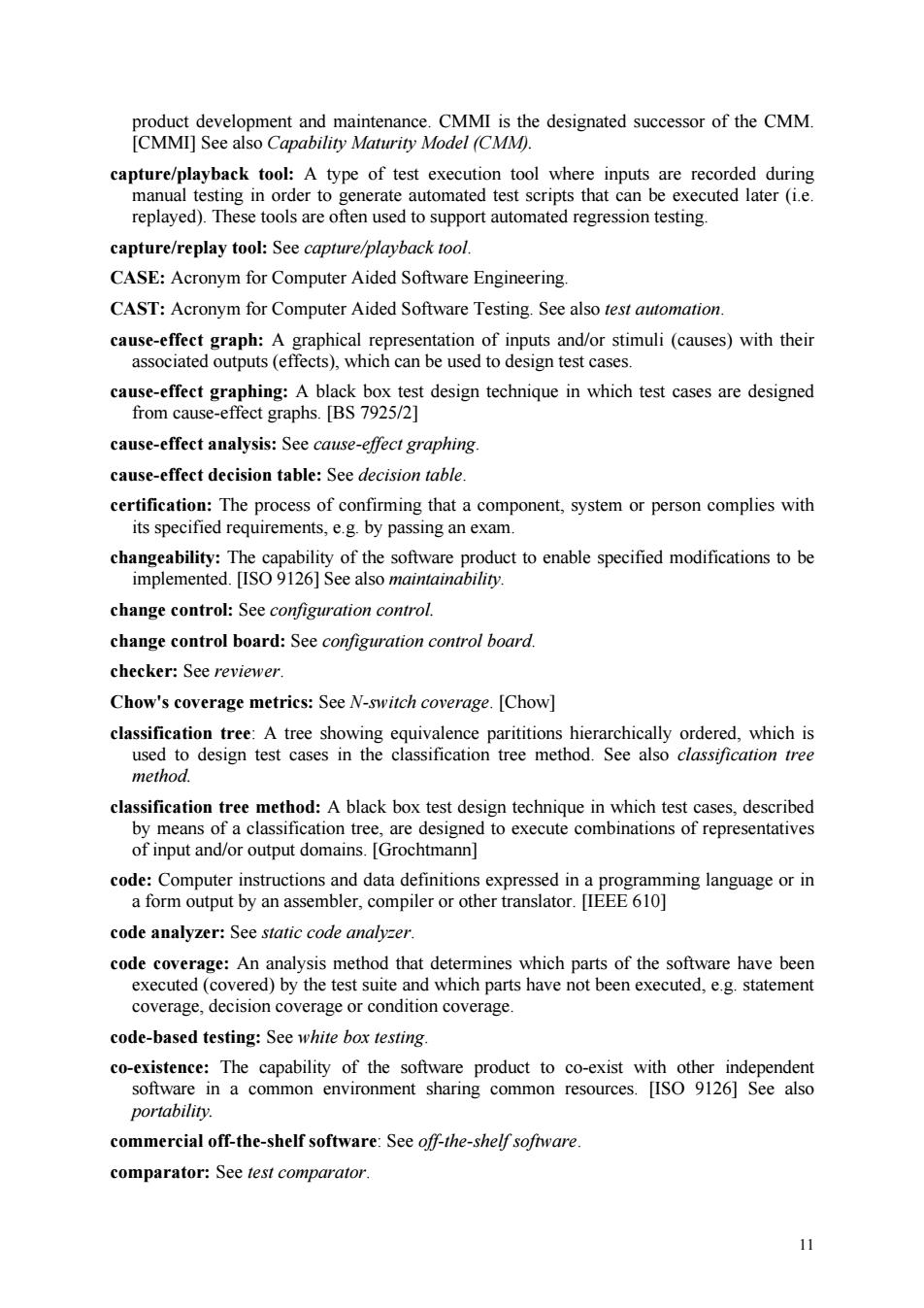正在加载图片...

product development and maintenance.CMMI is the designated successor of the CMM. [CMMI]See also Capability Maturity Model (CMM). capture/playback tool:A type of test execution tool where inputs are capture/replay tool:See capture/playback tool. CASE:Acronym for Computer Aided Software Engineering. CAST:Acronym for Computer Aided Software Testing.See also test automation. utputs(effects),whic cause-effect graphing:A black box test design technique in which test cases are designed from cause-effect graphs.[BS 7925/2] cause-effect analysis:See cause-effect graphing. cause-effect decision table:See decision table component,system or person complies with changeability:The capability of the software product to enable specified modifications to be implemented.[ISO 9126]See also maintainability. change control:See configuration control. change control board:See configuration control board. checker:See reviewer Chow's coverage metrics:See N-switch coverage.[Chow] classification tree:A tree showing equivalence parititions hierarchically ordered,which is used to design test cases in the classification tree method.See also classification tree method. classification tree black box test design technique in which test cases described a cl to execute combinations of representatives code:Computer instructions and data definitions expressed in a r rogramming language or in a form output by an assembler,compiler or other translator.[EEE 610] code analyzer:See static code analyzer. code coverage:An analysis method that determines which parts of the software have been overed)by the test suite and which parts have not been executed,e.g.statement coverage,decision coverage or condition coverage. code-based testing:See white box testing co-existence:The capability of the software product to co-exist with other independent software in a common environment sharing common resources.[ISO 9126]See also portability. commercial off-the-shelf software:See off-the-shelf sofiware. comparator:See test comparator 11 11 product development and maintenance. CMMI is the designated successor of the CMM. [CMMI] See also Capability Maturity Model (CMM). capture/playback tool: A type of test execution tool where inputs are recorded during manual testing in order to generate automated test scripts that can be executed later (i.e. replayed). These tools are often used to support automated regression testing. capture/replay tool: See capture/playback tool. CASE: Acronym for Computer Aided Software Engineering. CAST: Acronym for Computer Aided Software Testing. See also test automation. cause-effect graph: A graphical representation of inputs and/or stimuli (causes) with their associated outputs (effects), which can be used to design test cases. cause-effect graphing: A black box test design technique in which test cases are designed from cause-effect graphs. [BS 7925/2] cause-effect analysis: See cause-effect graphing. cause-effect decision table: See decision table. certification: The process of confirming that a component, system or person complies with its specified requirements, e.g. by passing an exam. changeability: The capability of the software product to enable specified modifications to be implemented. [ISO 9126] See also maintainability. change control: See configuration control. change control board: See configuration control board. checker: See reviewer. Chow's coverage metrics: See N-switch coverage. [Chow] classification tree: A tree showing equivalence parititions hierarchically ordered, which is used to design test cases in the classification tree method. See also classification tree method. classification tree method: A black box test design technique in which test cases, described by means of a classification tree, are designed to execute combinations of representatives of input and/or output domains. [Grochtmann] code: Computer instructions and data definitions expressed in a programming language or in a form output by an assembler, compiler or other translator. [IEEE 610] code analyzer: See static code analyzer. code coverage: An analysis method that determines which parts of the software have been executed (covered) by the test suite and which parts have not been executed, e.g. statement coverage, decision coverage or condition coverage. code-based testing: See white box testing. co-existence: The capability of the software product to co-exist with other independent software in a common environment sharing common resources. [ISO 9126] See also portability. commercial off-the-shelf software: See off-the-shelf software. comparator: See test comparator